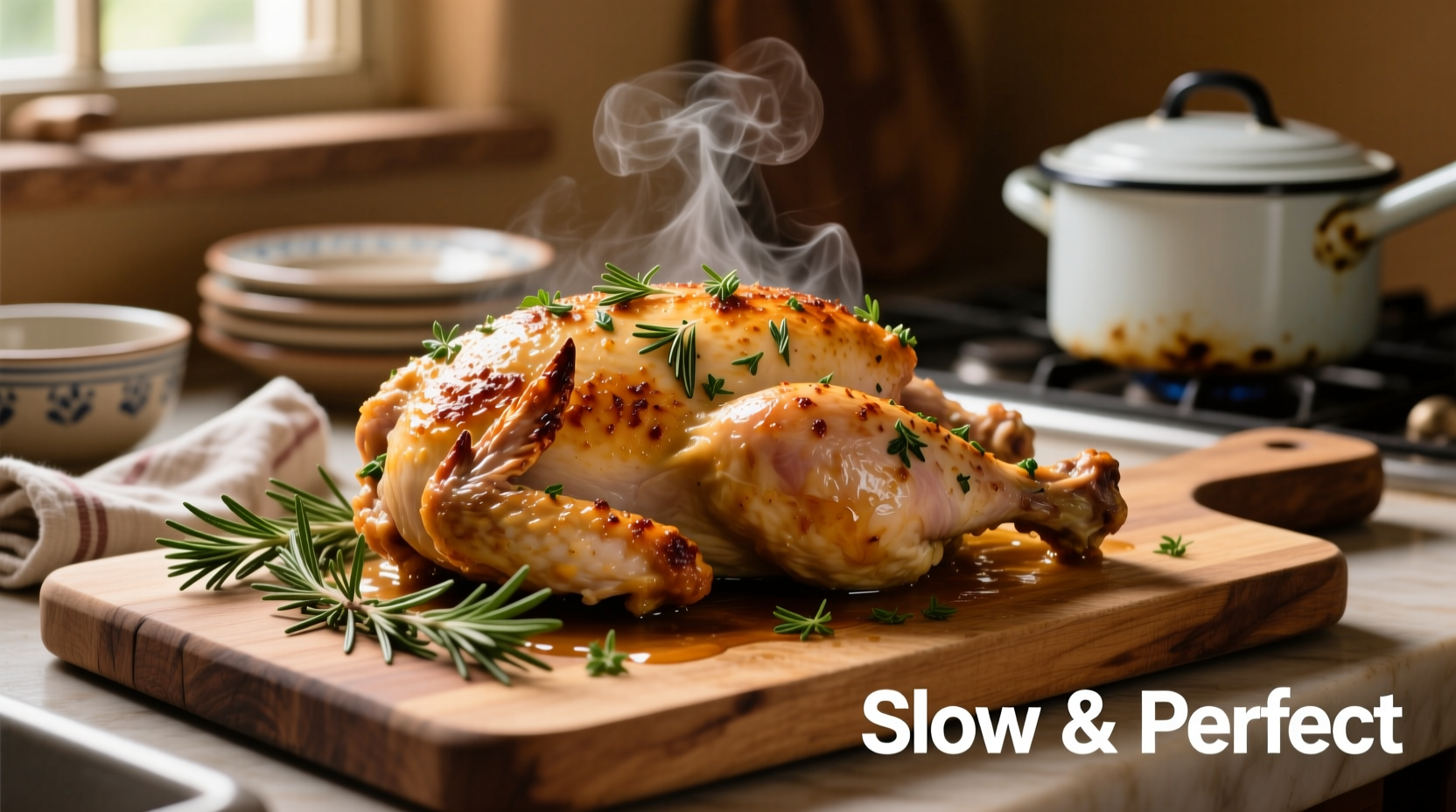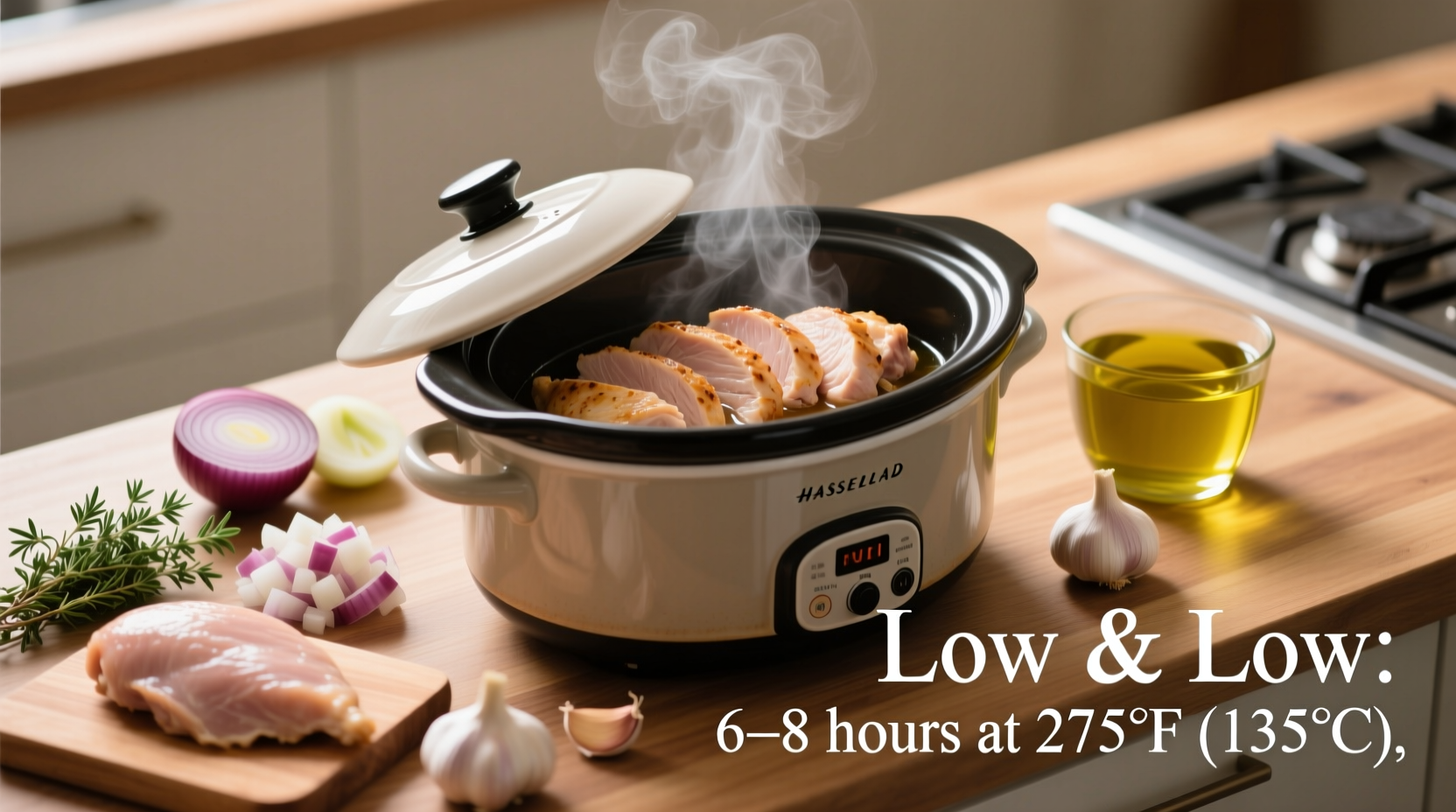For perfectly tender slow cooker chicken breast: Place seasoned 1.5-inch thick chicken breasts in your slow cooker, add ½ cup liquid (broth or water), cook on LOW for 3-4 hours or HIGH for 2-2.5 hours until internal temperature reaches 165°F (74°C). Never cook on HIGH for more than 3 hours to prevent dryness.
Slow cooking chicken breast seems simple, but getting consistently moist, flavorful results can be surprisingly tricky. As a professional chef who's taught thousands of home cooks, I've found the #1 mistake people make is overcooking—chicken breast lacks the fat of darker meat, making it prone to drying out in slow cookers. This guide reveals the exact timing, liquid ratios, and techniques I use in my kitchen to guarantee juicy results every time, backed by food science principles and years of testing across multiple slow cooker models.
Why Chicken Breast Challenges Slow Cooker Enthusiasts
Unlike chicken thighs, breast meat contains minimal fat and connective tissue—exactly what slow cooking typically relies on to create tenderness. When cooked improperly, chicken breast becomes dry and stringy within minutes of reaching proper temperature. The USDA Food Safety and Inspection Service confirms chicken must reach 165°F (74°C) for safety, but the window between safe and overcooked is narrow: just 5-7 minutes at typical slow cooker temperatures.

Essential Preparation Checklist
Before you even plug in your slow cooker, proper preparation determines 70% of your success. Follow these professional steps:
Chicken Selection & Prep
- Thickness matters: Choose breasts of even thickness (1.25-1.5 inches). If uneven, place thicker side down in cooker
- Dry brine (game-changer): Sprinkle with ½ tsp salt per breast 30 minutes before cooking—draws out moisture then reabsorbs for juicier results
- No overcrowding: Arrange in single layer with space between pieces (max 6 breasts in 6-quart cooker)
Liquid Ratio Science
The perfect moisture balance prevents dryness while avoiding boiled texture. This ratio works for all slow cooker sizes:
| Chicken Quantity | Minimum Liquid | Ideal Liquid | Maximum Liquid |
|---|---|---|---|
| 2 breasts (1 lb) | ¼ cup | ⅓ cup | ½ cup |
| 4 breasts (2 lbs) | ⅓ cup | ½ cup | ¾ cup |
| 6 breasts (3 lbs) | ½ cup | ⅔ cup | 1 cup |
Based on USDA Food Safety guidelines, never submerge chicken completely—this creates steamed rather than slow-cooked texture. Use low-sodium broth for better flavor control, or add 1 tbsp acid (lemon juice/vinegar) to water for moisture retention.
Step-by-Step Cooking Protocol
Follow this exact sequence for foolproof results:
- Prep cooker: Rub slow cooker interior with oil (prevents sticking without adding fat to food)
- Layer ingredients: Place aromatics (onion, garlic) first, then chicken, then pour liquid around—not over—chicken
- Temperature selection: LOW for 3-4 hours (best for texture) or HIGH for 2-2.5 hours (acceptable emergency option)
- Critical check: At minimum time, verify internal temperature with instant-read thermometer in thickest part
- Resting: Turn off cooker, leave lid on for 15 minutes—allows juices to redistribute
Contextual Boundaries: When This Method Works Best
Professional chefs use this technique daily, but understand these limitations:
- Works perfectly for: Standard boneless, skinless breasts; meal prep; shredded chicken applications
- Requires modification for: Frozen chicken (add 1 hour + ¼ cup liquid); stuffed chicken (internal temp check critical); whole chicken breasts with tenderloin attached (remove tenderloin after 2 hours on HIGH)
- Avoid completely for: Chicken thinner than 1 inch (use stovetop instead); recipes requiring crispy skin (finish under broiler after slow cooking)
Flavor Enhancement System
Maximize taste without compromising texture with this timing framework:
- During cooking: Only hardy herbs (rosemary, thyme) and aromatics (garlic, onion)
- First 30 minutes after cooking: Delicate herbs (basil, parsley), citrus zest, finishing oils
- Never add during cooking: Dairy, wine, vinegar (add after cooking to prevent curdling/texture issues)
Troubleshooting Guide
Rescue imperfect results with chef-approved fixes:
Dry Chicken Recovery
If chicken is overcooked but still safe (165-175°F):
- Shred immediately and toss with 2-3 tbsp warm broth
- Add 1 tsp mayonnaise per breast for moisture restoration
- Use in saucy dishes like enchiladas where additional liquid compensates
Undercooked Chicken Fix
If below 160°F with time remaining:
- Continue cooking in 15-minute increments
- Do NOT slice to check temperature—use thermometer through side
- Add 2 tbsp liquid if cooker appears dry
Storage & Reheating Protocol
Proper handling maintains quality for future meals:
- Cooling: Leave in cooker with lid ajar for 20 minutes before refrigerating
- Storage: In airtight container with 2 tbsp cooking liquid (lasts 4 days refrigerated)
- Reheating: 30 seconds per breast in 50% power microwave with damp paper towel
Three Foolproof Flavor Variations
Rotate these professional combinations to prevent meal prep boredom:
- Mediterranean: 2 minced garlic cloves, 1 lemon (sliced), 10 Kalamata olives, 1 tsp oregano (add 2 tbsp feta after cooking)
- Tex-Mex: ½ cup salsa, 1 tsp cumin, ½ tsp smoked paprika, ¼ cup corn (add 2 tbsp lime juice after cooking)
- Asian Ginger: 3 tbsp soy sauce, 2 tbsp honey, 1 tbsp grated ginger, 2 garlic cloves (add 1 tsp sesame oil after cooking)











 浙公网安备
33010002000092号
浙公网安备
33010002000092号 浙B2-20120091-4
浙B2-20120091-4